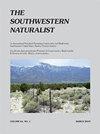ORIGINS AND DIVERSITY OF PERIPHERAL POPULATIONS OF RIO GRANDE SUCKER (PANTOSTEUS PLEBEIUS) IN THE SOUTHWESTERN UNITED STATES
IF 0.2
4区 环境科学与生态学
Q4 Agricultural and Biological Sciences
引用次数: 0
Abstract
Abstract Rio Grande sucker (Pantosteus plebeius) is continuously distributed in parts of its range, but occurs in geographically isolated populations at the periphery. We used 10 microsatellites and DNA sequence data from the mitochondrial cytochrome b gene to characterize genetic diversity and reconstruct evolutionary relationships of five peripheral populations in the southwestern United States. An isolated population in Rio Bonito (Pecos River drainage) is most closely related to a central Rio Grande population in Alamosa Creek, and part of the monophyletic Rio Grande lineage. Another disjunct population, Bluewater Creek in the western Rio Grande drainage, has a Mimbres lineage mtDNA haplotype that likely originated via interbasin transfer. Both peripheral populations are important for conservation of the species as a whole. Three other isolated populations are closely related to mainstem “core” populations in the Mimbres and Gila rivers that colonized these intermittently connected tributaries. One peripheral population in Allie Canyon, Mimbres River, has persisted longer in isolation than Rocky Canyon or Trout Creek in the Gila system. In general, a process of range expansion during relatively cool and wet periods, followed by retreat to wetted refugia during warm and dry periods, leads to genetic differentiation of peripheral populations of Rio Grande sucker at local and across-basin scales.美国西南部大吸盘(pantosteus plebeius)外围种群的起源和多样性
[摘要]大吸盘(Pantosteus plebeius)在其部分范围内连续分布,但在外围以地理孤立的种群出现。我们使用10个微卫星和线粒体细胞色素b基因的DNA序列数据来表征遗传多样性并重建美国西南部5个外围种群的进化关系。里约热内卢Bonito (Pecos河流域)的一个孤立种群与Alamosa Creek的一个中央里约热内卢Grande种群关系最密切,并且是里约热内卢Grande单系谱系的一部分。另一个分离的种群,在西部里约热内卢大流域的蓝水溪,有一个Mimbres谱系mtDNA单倍型,可能起源于盆地间转移。这两个外围种群对整个物种的保护都很重要。另外三个孤立的种群与在这些间歇性连接的支流上定居的米布雷斯河和吉拉河的主要“核心”种群密切相关。阿利峡谷的一个外围种群,米姆布雷斯河,比吉拉系统中的洛基峡谷或鳟鱼溪更长久地与世隔绝。总的来说,在相对凉爽和潮湿的时期,活动范围扩大,然后在温暖和干燥的时期退缩到潮湿的避难所,导致里约热内卢大吸盘外围种群在局部和跨流域尺度上的遗传分化。
本文章由计算机程序翻译,如有差异,请以英文原文为准。
求助全文
约1分钟内获得全文
求助全文
来源期刊

Southwestern Naturalist
环境科学-生态学
CiteScore
0.50
自引率
50.00%
发文量
47
审稿时长
18-36 weeks
期刊介绍:
The Southwestern Naturalist (a publication of the Southwestern Association of Naturalists since 1953) is an international journal (published quarterly) that reports original and significant research in any field of natural history. This journal promotes the study of plants and animals (living and fossil) in the multinational region that includes the southwestern United States, Mexico, and Central America. Appropriate submission of manuscripts may come from studies conducted in the countries of focus or in regions outside this area that report significant findings relating to biota occurring in the southwestern United States, Mexico, and Central America. Publication is in English, and manuscripts may be feature articles or notes. Feature articles communicate results of completed scientific investigations, while notes are reserved for short communications (e.g., behavioral observations, range extensions, and other important findings that do not in themselves constitute a comprehensive study). All manuscripts (feature articles and notes) require an abstract in both English and Spanish.
 求助内容:
求助内容: 应助结果提醒方式:
应助结果提醒方式:


